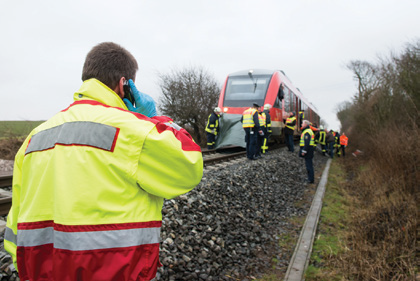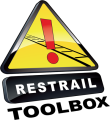As with the general guidance on preventative interventions, it is important that post incident response mitigation measures are considered and a similar approach has been taken as in the table below.
 Railway suicides and trespassing accidents are an important cause of delays. The response to incidents involving suicides or fatal trespassing incidents will thus be aligned with the processes of incident response planning, consultation/briefing, plan testing, actual incident response, management and review applied by RUs and IMs for any incident involving their operations (e.g. collisions and derailment).
Railway suicides and trespassing accidents are an important cause of delays. The response to incidents involving suicides or fatal trespassing incidents will thus be aligned with the processes of incident response planning, consultation/briefing, plan testing, actual incident response, management and review applied by RUs and IMs for any incident involving their operations (e.g. collisions and derailment).
In addition, as with preventative interventions context is important. For example the legal roles and responsibilities for responding organisations (e.g. police, fire and the RU/IM) may be different in Member States. How an RU/IM response is reflected in the plans will depend on each organisations resource capability also the particular circumstances and locations that can be involved. Use of the following approach enables contextual issues to be addressed when reviewing/developing post incident response mitigation arrangements in order to achieve a better punctuality of the services.
| Actions | Questions to be answered | Issues to be considered |
|---|---|---|
| Who are the partners and stakeholders likely to be involved in incident response planning, the actual response and ongoing review of these arrangements? | -* Police -* Fire service -* EMS -* Legal entities -* RU & IM responders on & off site including media -* RU & IM contractors (e.g. clean up) | |
| What are the legal responsibilities of the organisations likely to be involved in an incident response? | -* Incident response management, roles & responsibilities -* Legal considerations -* Health & safety requirements -* Investigation responsibilities -* Ethical requirements | |
| What rail industry requirements are applicable to incident response? | -* Incident response planning -* Incident response organisation, roles & responsibilities -* Coordinated incident management | |
| Incident conclusion delay elements | What specific response and incident site aspects may delay conclusion of an incident & traffic restoration? | -* Delayed/inadequate notification of an incident from site to the RU & IM OCCs -* Inadequate liaison between RU & IM OCCs -* Delayed/unclear advice from OCCs to external responders -* Unclear identification of suitable track/location access point to responding entities including IM/RU contractors -* Distance from response resource location to the incident site -* Locations with difficult access -* Unclear understanding by responding organisations of each others expectations, roles and responsibilities -* Not making site information available quickly (e.g. train driver, OTDR, FFCCTV) and associated responsibilities -* Arrangements for safe evacuation of stranded trains and alternative transport not organized promptly and insufficiently resourced -* Arrangements for welfare of passengers in stranded trains |
| Incident conclusion accelerators | What actions can achieve the earliest possible conclusion of an incident and traffic restoration? | -* Prompt/adequate notification of an incident from site to the RU & IM OCCs -* Making site information available quickly (e.g. train driver, OTDR, FFCCTV) and associated responsibilities -* Adequate liaison between RU & IM OCCs -* Prompt/informative advice from OCCs to external responders -* Agreed lines of communication with necessary equipment on site, between site and OCCs and between OCCs and external responders. -* Clear identification of suitable track/location access point to responding entities including IM/RU contractors -* Response resources located at appropriate distance from anticipated incident sites -* Clear understanding by responding organisations of each others expectations, roles and responsibilities -* Arrangements for safe evacuation of stranded trains and alternative transport organized promptly and sufficiently resourced -* Appropriate arrangements for welfare of passengers in stranded trains -* Making information for investigation decision making available quickly (e.g. train driver, OTDR, FFCCTV). |
| Evaluation pre implementa-tion of revised arrangements | How effective are existing incident response arrangements? | -* Records of response time by responding entities to an incident site -* Records of times to conclude incidents and restore traffic operation |
| Are there any resource constraints for revised arrangements? | -* Equipment for handling/moving fatalities to clear the site -* Clean up equipment -* Location of response staff to potential incident sites | |
| Are communication arrangements effective? | -* Lines of communication -* Information requirements -* Equipment | |
| How will revised arrangements be tested? | -* Exercises involving all responders | |
| Implementation | How will revised arrangements be put into practice? | -* Revised RU/IM procedures -* Briefing response plan arrangements within RUs & IMs and their contractors -* Consultation /briefing involving external responding organisations - MOU arrangements -* Production of information leaflets/documentation |
| Are the necessary response resources – people/equipment) available? | -* Checking resource provision -* Responsibility for resource provision -* Funding of resources & by which organisation | |
| Evaluation | How will the expected benefits of the revised arrangement be evaluated? | -* Setting target time for service resumption from incident occurrence. -* Record for incidents of time from start of incident to conclusion and service resumption -* Records of arrival time of key decision makers on site (e.g. Police) -* Internal RU or IM review meetings -* Review meetings with external responders -* Review of individual incident response arrangements |
| How will identified improvements be promulgated | -* Internal RU or IM review meetings -* Review meetings with external responders | |
Other useful tools have been developed outside RESTRAIL . For example, RSSB developed a cross-rail industry Bow Tie for trespass risk. The Bow Tie approach provides a visual illustration of what controls are in place to mitigate certain hazards. This can help the decision-maker poritise these mitigation measures and develop an action plan.

